The Intel SSD 540s (480GB) Review
by Billy Tallis on June 23, 2016 9:00 AM ESTATTO
ATTO's Disk Benchmark is a quick and easy freeware tool to measure drive performance across various transfer sizes.
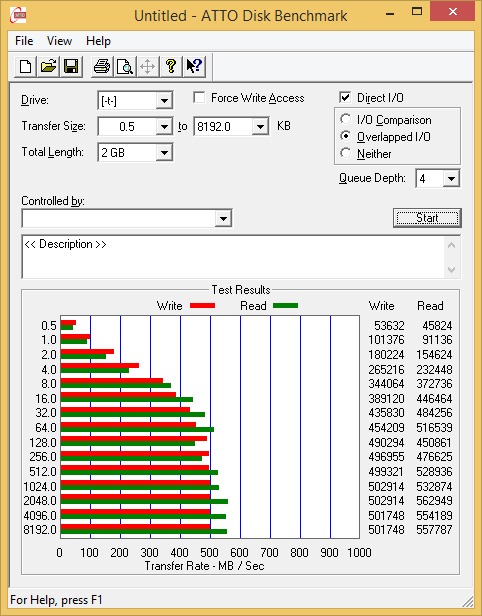 |
|||||||||
The Intel 540s's performance is a bit uneven during the ATTO benchmark, but its write speed advantage over the SP550 is still quite clear.
AS-SSD
AS-SSD is another quick and free benchmark tool. It uses incompressible data for all of its tests, making it an easy way to keep an eye on which drives are relying on transparent data compression. The short duration of the test makes it a decent indicator of peak drive performance.
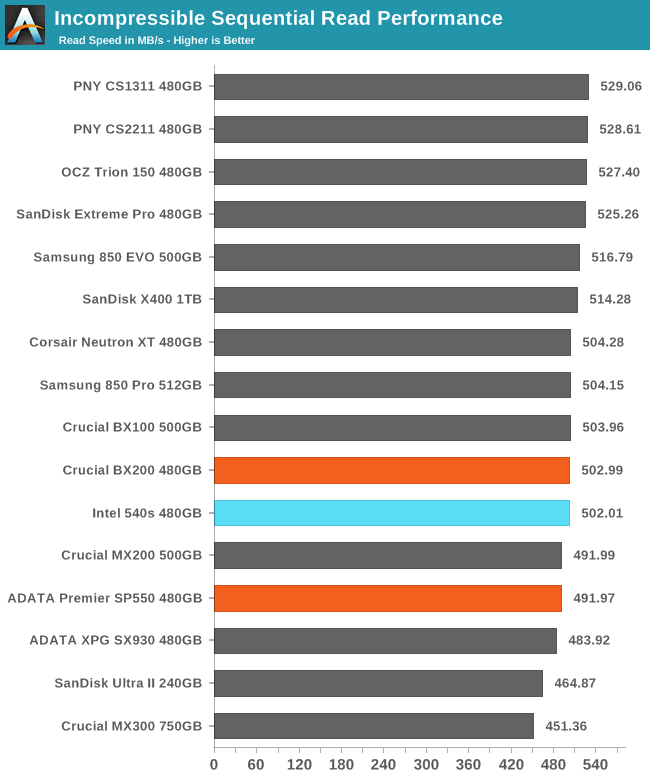
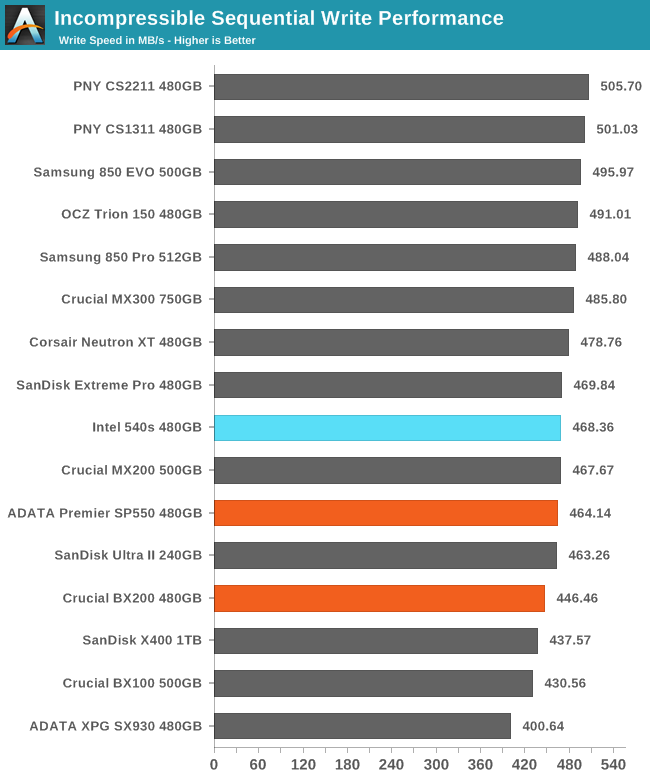
The AS-SSD test does very little to differentiate between drives, but it at least shows that the Intel 540s can reach similar peak speeds to its competition.
Idle Power Consumption
Since the ATSB tests based on real-world usage cut idle times short to 25ms, their power consumption scores paint an inaccurate picture of the relative suitability of drives for mobile use. During real-world client use, a solid state drive will spend far more time idle than actively processing commands. Our testbed doesn't support the deepest DevSlp power saving mode that SATA drives can implement, but we can measure the power usage in the intermediate slumber state where both the host and device ends of the SATA link enter a low-power state and the drive is free to engage its internal power savings measures.
We also report the drive's idle power consumption while the SATA link is active and not in any power saving state. Drives are required to be able to wake from the slumber state in under 10 milliseconds, but that still leaves plenty of room for them to add latency to a burst of I/O. Because of this, many desktops default to either not using SATA Aggressive Link Power Management (ALPM) at all or to only enable it partially without making use of the device-initiated power management (DIPM) capability. Additionally, SATA Hot-Swap is incompatible with the use of DIPM, so our SSD testbed usually has DIPM turned off during performance testing.
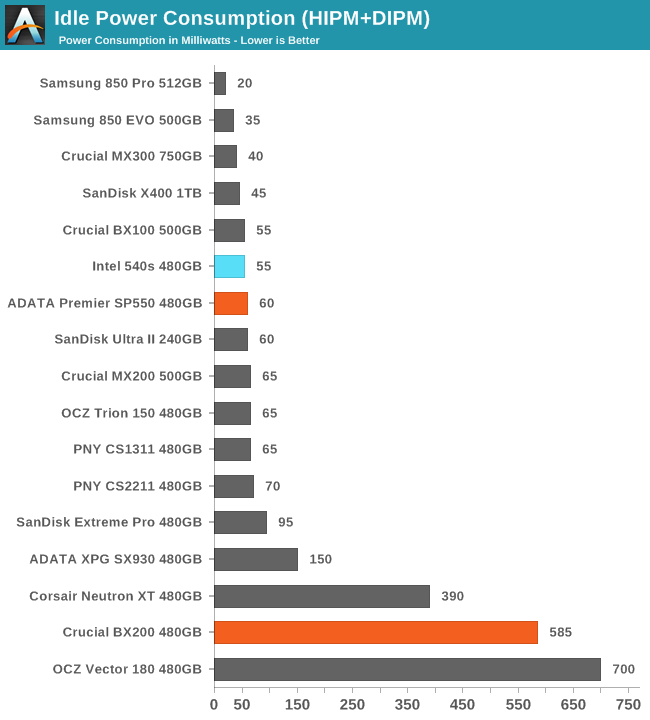
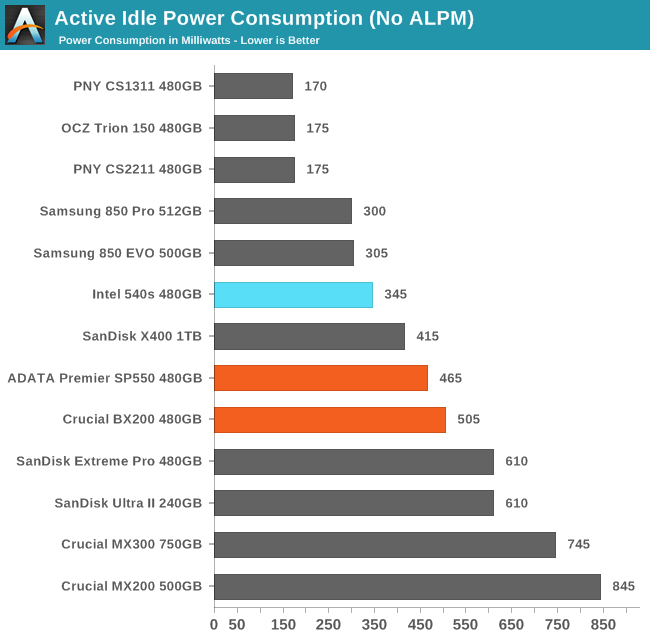
The slumber power state is working correctly on the Intel 540s and allows for very slightly lower idle power draw than the SP550. Active idle power is significantly improved over the SM2256 and is now behind only Samsung and Phison controllers. Silicon Motion's 40nm SM2258 clearly beats Marvell's 28nm 88SS1074 used in the SanDisk X400 and Crucial MX300.










77 Comments
View All Comments
cbjwthwm - Tuesday, June 28, 2016 - link
I'll pay a premium vs a generic like the SP550 because:1. Intel will undoubtedly manufacture the drive to reliable standards
2. it will be supported by a decent toolbox utility (eg: ADATA's is buggy junk)
3. Intel will rake SMI's controller firmware over the coals, like it did with Sandforce--an update has already been released since this review
4. its firmware update process will be simple & reliable
I picked up an SP550 for eval which eventually needed a firmware update. After experiencing the SP550's nasty firmware update process (a disorganized DIY mess), I now use BX200's as the cheapest drive choice simply because firmware updates are competently packaged. I've also had scenarios where fully updated OCZ Trions had terrible stuttering, and imaging to a BX200 solved the issue as well.
I see Intel's 540s as the combination of what the SMI-based TLC products like the SP550 and BX200 should be, if you combine their positive attributes (beyond price)--and for light load applications those benefits could sway me away from equivalently priced MLC-based drives with similar support issues and potential reliability compromises.
Samsung also has crappy firmware support (eg: the repeated 840 EVO performance fixes, and the 850 series update bricking issues which were pulled) so I rarely ever use them. Samsung may have an engineering lead, but they have a well established history as a consistently reckless company when it comes to support.
vladx - Tuesday, June 28, 2016 - link
Another idiot spreading FUD about Samsung. 840 EVO works great and as new after applying the fix. Stuff like the trash you posted starts stupid myths that average joes keep repeating.cbjwthwm - Wednesday, June 29, 2016 - link
Myths? There is an established track record with them, widely reported and easy to find.1. Multiple rounds of 840 EVO firmware: http://www.anandtech.com/show/9196/samsung-release...
2. 850 firmware pulled, and the ISOs were never re-released: http://www.guru3d.com/news-story/after-samsung-840...
fanofanand - Thursday, June 30, 2016 - link
The evo issue was legitimate. That said, it isn't like Intel hasn't released a few turds in their day as well. Between broken AVX and numerous other problems, Intel is not the holy grail of perfection and quality control. Samsung has at least as strong a track record for reliability with their drives as Intel, so it makes no sense to purchase this over the comparatively priced Samsung drive. You reference "premium vs generic" but line this up in the premium vs premium space and you will find this drive underperforms and is overpriced. You are either an Intel shareholder, employee, or don't use critical thinking when it comes to your beloved brand.vladx - Thursday, June 30, 2016 - link
There were issues which they fixed. I call that great support from Samsung. It's FUD to say Samsung has a bad history based on fixed issues.Prof-Q - Tuesday, August 16, 2016 - link
If Intel 540 and Adata SP550 used the same NAND, then why Intel's performance is so much better in UsersBenchmark?I was about to buy Intel but this article made me reconsider the options
SeanJ76 - Tuesday, October 4, 2016 - link
Intel will still be the king of SSD's, their top tier is no 1 in speed and reliability(Pci-e) version, their mid tier is holding their own as well, and their entry level tier, 540 series, is so damn affordable for the reliability who wouldn't buy them? I own 4 Intel 520/535 series currently, 2 of them are over 5 yrs old and they are still at 100% life span according to Intel's Toolbox. The main difference in brands is reliability, now that they're all pretty much on par with speed, you should go with the reliability winner which is none other than INTEL!